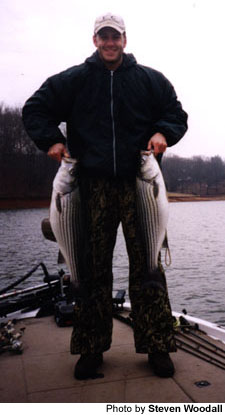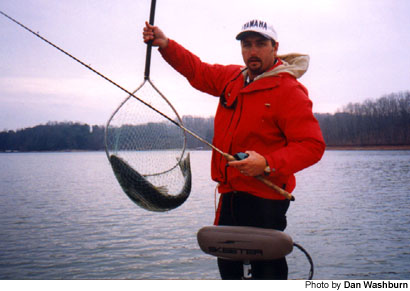
January 12, 1999 — I was watching a sea gull when it happened.
I was hypnotized by the bird. It would dive to the water’s surface, bounce back into the air, and hover. Then it would do it again.
Up. And down.
Fishing for striped bass is a waiting game. And a day spent marking stripers allows you to get lost in minutia, such as a gull feeding on Lake Lanier.
Up. And down.
And then it happens.
“Catch that fish!” yelled my guide Steven Woodall, breaking my trance.
One of the fishing rods off the back of our bass boat was doubled over. The bait alarm on the reel was clicking like crazy. A striper had struck.
I hurried to the back of the boat and took the rod in my hands, ready for the inevitable fight.
“They pull hard,” warned Woodall earlier in the day. “It’s like tying a line to the end of a Volkswagen.”
Must be a van, I thought, feeling the force of the fish.
I pulled back on the rod. The line tightened. The rod bowed. I let the rod down, and reeled in. Then I did it again.
Pull back. Reel in.
My heart was racing. I was doing battle with an unseen foe — one I’m sure that wanted to keep it that way. But I was determined not to let my first striper get away.
Pull back. Reel in.
After about 10 minutes of tussling with the feisty lineside, I prevailed. I brought him to the surface and Woodall snatched him up with a net.
Thirteen pounds. Thirty-four inches. Not bad.
But these are average measurements for a striper caught in Lake Lanier, which explains why the big fish has attracted such a fanatical following among Georgia anglers during the past decade.
“They really pull, don’t they?” said Woodall with a knowing smile as I caught my breath and admired my catch. “If you don’t get excited doing this, you have no business being on a fishing boat.”
Stripers are a Lanier guide’s best friend. Woodall, one of many fishing guides on Lanier — arguably the top striper lake in the South — takes nearly 500 clients fishing in a year, and 90 percent of them want to go after the striper.
“It’s because they’re so big,” Woodall explained. “You just don’t come out and catch a fish that’ll go 10 pounds or better out of fresh water that often.”
That is unless you’re striper fishing on Lanier. Woodall says the average striper in the lake weighs 10-15 pounds, and it’s not uncommon to boat one that goes well into the 30s. Lanier’s record lunker is a 46-pounder caught in 1987.
Size matters, but that’s not the striper’s only draw.
“They’re an awesome fish to catch,” said Woodall. “In fresh water, there’s nothing else you can catch that’s going to give you that type of fight. If you come here with a cheap reel, they’ll bust it. Absolutely tear it up.”
The striper supply is plentiful in Lanier, also. Last year, the lake was stocked with nearly 550,000 striper fingerlings, adding to an already healthy population.
Yes, they’re out there. But where? That is where guide’s like Woodall come into play.
Woodall, 32, his face tanned in the dead of winter, has been a Lanier guide for six years, but the north Hall County native has fished the lake his entire life.
He bought his first bass boat when he was in the eleventh grade.
Woodall knows the ways of the striper. He knows how to track them. And that’s the most important aspect of striper fishing.
“Stripers are like a pack of wolves,” said Woodall. “They are and open-water fish and they’re constantly on the move looking for food. You may catch 12 or 13 of them in one place today and go back tomorrow and not get bit. Those same fish may be 12 or 15 miles away by the next day. So you have to look for them.”
And look for them we did.
Stripers live to eat. Their main forage: thread-finned and gizzard shad. If there are no bait fish in the water, there are no stripers.
So at 7 a.m. we set out from the Sardis Creek boat ramp looking for shad. When there are a lot of them you can see circular ripples forming on top of the water, and Woodall’s keen eye can pick them out from a great distance, even on a speeding boat.
An even better signal of bait fish are the gulls, which feed on shad forced to the surface by stripers down below.
“Those birds are the best fish finders on this lake,” said Woodall.
Once Woodall picks a spot, he stops the boat, baits four lines (we were using live golden trout) and puts the rods in the rod holders on each corner of the boat. Then he turns on the trolling motor and slowly maneuvers the boat around as he looks for stripers on the screen of his high-tech depth finder.
Before we got any bites, we had already hit a few different locales: an old pond dam just south of Thompson Bridge, Ada Creek and Gainesville Creek.
Then a tip from another guide — they work as a team, communicating by radio — sent us to Wahoo Creek, where the gulls were circling.
It wasn’t long before the stripers struck. Woodall hooked a 15-pounder minutes after I boated mine.

That’s what happens with stripers. They strike in bunches. And then you wait.
“It’s kind of like deer hunting,” said Woodall. “You sit and wait for them to come under. They come to you and you catch a couple of them and then they are gone. Sometimes it’s a slow bite. But it is a big fish.”
And, believe me, it’s worth the wait.
